Masahiro Yasuda
Description and Discussion on DCASE 2025 Challenge Task 4: Spatial Semantic Segmentation of Sound Scenes
Jun 12, 2025Abstract:Spatial Semantic Segmentation of Sound Scenes (S5) aims to enhance technologies for sound event detection and separation from multi-channel input signals that mix multiple sound events with spatial information. This is a fundamental basis of immersive communication. The ultimate goal is to separate sound event signals with 6 Degrees of Freedom (6DoF) information into dry sound object signals and metadata about the object type (sound event class) and representing spatial information, including direction. However, because several existing challenge tasks already provide some of the subset functions, this task for this year focuses on detecting and separating sound events from multi-channel spatial input signals. This paper outlines the S5 task setting of the Detection and Classification of Acoustic Scenes and Events (DCASE) 2025 Challenge Task 4 and the DCASE2025 Task 4 Dataset, newly recorded and curated for this task. We also report experimental results for an S5 system trained and evaluated on this dataset. The full version of this paper will be published after the challenge results are made public.
Towards Pre-training an Effective Respiratory Audio Foundation Model
May 21, 2025Abstract:Recent advancements in foundation models have sparked interest in respiratory audio foundation models. However, the effectiveness of applying conventional pre-training schemes to datasets that are small-sized and lack diversity has not been sufficiently verified. This study aims to explore better pre-training practices for respiratory sounds by comparing numerous pre-trained audio models. Our investigation reveals that models pre-trained on AudioSet, a general audio dataset, are more effective than the models specifically pre-trained on respiratory sounds. Moreover, combining AudioSet and respiratory sound datasets for further pre-training enhances performance, and preserving the frequency-wise information when aggregating features is vital. Along with more insights found in the experiments, we establish a new state-of-the-art for the OPERA benchmark, contributing to advancing respiratory audio foundation models. Our code is available online at https://github.com/nttcslab/eval-audio-repr/tree/main/plugin/OPERA.
Assessing the Utility of Audio Foundation Models for Heart and Respiratory Sound Analysis
Apr 25, 2025



Abstract:Pre-trained deep learning models, known as foundation models, have become essential building blocks in machine learning domains such as natural language processing and image domains. This trend has extended to respiratory and heart sound models, which have demonstrated effectiveness as off-the-shelf feature extractors. However, their evaluation benchmarking has been limited, resulting in incompatibility with state-of-the-art (SOTA) performance, thus hindering proof of their effectiveness. This study investigates the practical effectiveness of off-the-shelf audio foundation models by comparing their performance across four respiratory and heart sound tasks with SOTA fine-tuning results. Experiments show that models struggled on two tasks with noisy data but achieved SOTA performance on the other tasks with clean data. Moreover, general-purpose audio models outperformed a respiratory sound model, highlighting their broader applicability. With gained insights and the released code, we contribute to future research on developing and leveraging foundation models for respiratory and heart sounds.
M2D2: Exploring General-purpose Audio-Language Representations Beyond CLAP
Mar 28, 2025Abstract:Contrastive language-audio pre-training (CLAP) has addressed audio-language tasks such as audio-text retrieval by aligning audio and text in a common feature space. While CLAP addresses general audio-language tasks, its audio features do not generalize well in audio tasks. In contrast, self-supervised learning (SSL) models learn general-purpose audio features that perform well in diverse audio tasks. We pursue representation learning that can be widely used in audio applications and hypothesize that a method that learns both general audio features and CLAP features should achieve our goal, which we call a general-purpose audio-language representation. To implement our hypothesis, we propose M2D2, a second-generation masked modeling duo (M2D) that combines an SSL M2D and CLAP. M2D2 learns two types of features using two modalities (audio and text) in a two-stage training process. It also utilizes advanced LLM-based sentence embeddings in CLAP training for powerful semantic supervision. In the first stage, M2D2 learns generalizable audio features from M2D and CLAP, where CLAP aligns the features with the fine LLM-based semantic embeddings. In the second stage, it learns CLAP features using the audio features learned from the LLM-based embeddings. Through these pre-training stages, M2D2 should enhance generalizability and performance in its audio and CLAP features. Experiments validated that M2D2 achieves effective general-purpose audio-language representation, highlighted with SOTA fine-tuning mAP of 49.0 for AudioSet, SOTA performance in music tasks, and top-level performance in audio-language tasks.
Baseline Systems and Evaluation Metrics for Spatial Semantic Segmentation of Sound Scenes
Mar 28, 2025Abstract:Immersive communication has made significant advancements, especially with the release of the codec for Immersive Voice and Audio Services. Aiming at its further realization, the DCASE 2025 Challenge has recently introduced a task for spatial semantic segmentation of sound scenes (S5), which focuses on detecting and separating sound events in spatial sound scenes. In this paper, we explore methods for addressing the S5 task. Specifically, we present baseline S5 systems that combine audio tagging (AT) and label-queried source separation (LSS) models. We investigate two LSS approaches based on the ResUNet architecture: a) extracting a single source for each detected event and b) querying multiple sources concurrently. Since each separated source in S5 is identified by its sound event class label, we propose new class-aware metrics to evaluate both the sound sources and labels simultaneously. Experimental results on first-order ambisonics spatial audio demonstrate the effectiveness of the proposed systems and confirm the efficacy of the metrics.
M2D-CLAP: Masked Modeling Duo Meets CLAP for Learning General-purpose Audio-Language Representation
Jun 04, 2024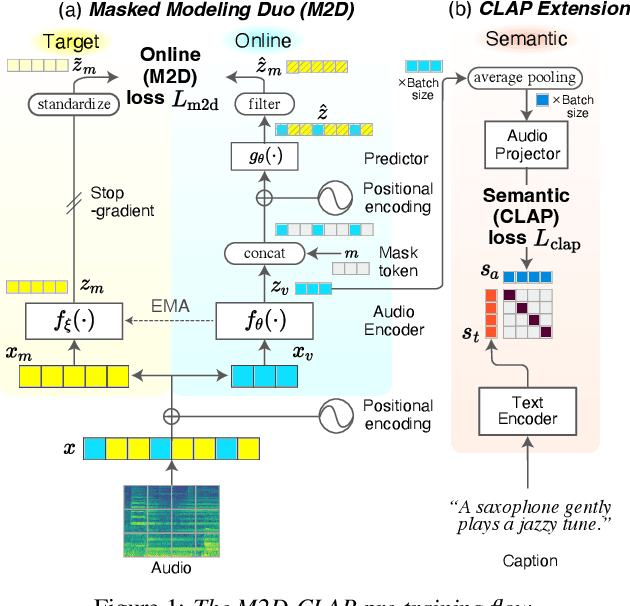



Abstract:Contrastive language-audio pre-training (CLAP) enables zero-shot (ZS) inference of audio and exhibits promising performance in several classification tasks. However, conventional audio representations are still crucial for many tasks where ZS is not applicable (e.g., regression problems). Here, we explore a new representation, a general-purpose audio-language representation, that performs well in both ZS and transfer learning. To do so, we propose a new method, M2D-CLAP, which combines self-supervised learning Masked Modeling Duo (M2D) and CLAP. M2D learns an effective representation to model audio signals, and CLAP aligns the representation with text embedding. As a result, M2D-CLAP learns a versatile representation that allows for both ZS and transfer learning. Experiments show that M2D-CLAP performs well on linear evaluation, fine-tuning, and ZS classification with a GTZAN state-of-the-art of 75.17%, thus achieving a general-purpose audio-language representation.
Guided Masked Self-Distillation Modeling for Distributed Multimedia Sensor Event Analysis
Apr 12, 2024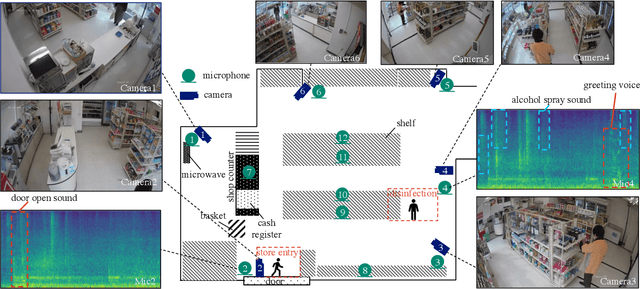
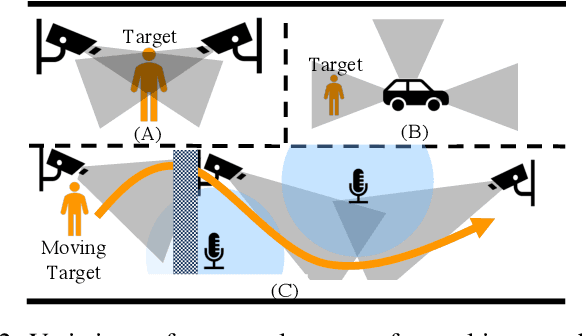
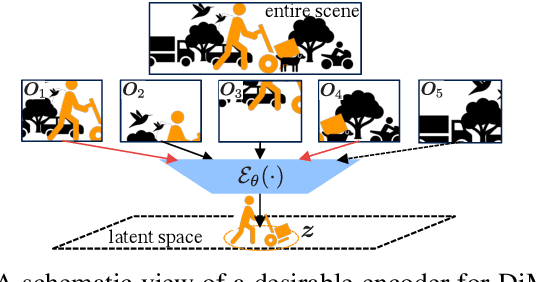

Abstract:Observations with distributed sensors are essential in analyzing a series of human and machine activities (referred to as 'events' in this paper) in complex and extensive real-world environments. This is because the information obtained from a single sensor is often missing or fragmented in such an environment; observations from multiple locations and modalities should be integrated to analyze events comprehensively. However, a learning method has yet to be established to extract joint representations that effectively combine such distributed observations. Therefore, we propose Guided Masked sELf-Distillation modeling (Guided-MELD) for inter-sensor relationship modeling. The basic idea of Guided-MELD is to learn to supplement the information from the masked sensor with information from other sensors needed to detect the event. Guided-MELD is expected to enable the system to effectively distill the fragmented or redundant target event information obtained by the sensors without being overly dependent on any specific sensors. To validate the effectiveness of the proposed method in novel tasks of distributed multimedia sensor event analysis, we recorded two new datasets that fit the problem setting: MM-Store and MM-Office. These datasets consist of human activities in a convenience store and an office, recorded using distributed cameras and microphones. Experimental results on these datasets show that the proposed Guided-MELD improves event tagging and detection performance and outperforms conventional inter-sensor relationship modeling methods. Furthermore, the proposed method performed robustly even when sensors were reduced.
6DoF SELD: Sound Event Localization and Detection Using Microphones and Motion Tracking Sensors on self-motioning human
Mar 04, 2024Abstract:We aim to perform sound event localization and detection (SELD) using wearable equipment for a moving human, such as a pedestrian. Conventional SELD tasks have dealt only with microphone arrays located in static positions. However, self-motion with three rotational and three translational degrees of freedom (6DoF) shall be considered for wearable microphone arrays. A system trained only with a dataset using microphone arrays in a fixed position would be unable to adapt to the fast relative motion of sound events associated with self-motion, resulting in the degradation of SELD performance. To address this, we designed 6DoF SELD Dataset for wearable systems, the first SELD dataset considering the self-motion of microphones. Furthermore, we proposed a multi-modal SELD system that jointly utilizes audio and motion tracking sensor signals. These sensor signals are expected to help the system find useful acoustic cues for SELD on the basis of the current self-motion state. Experimental results on our dataset show that the proposed method effectively improves SELD performance with a mechanism to extract acoustic features conditioned by sensor signals.
First-shot anomaly sound detection for machine condition monitoring: A domain generalization baseline
Mar 01, 2023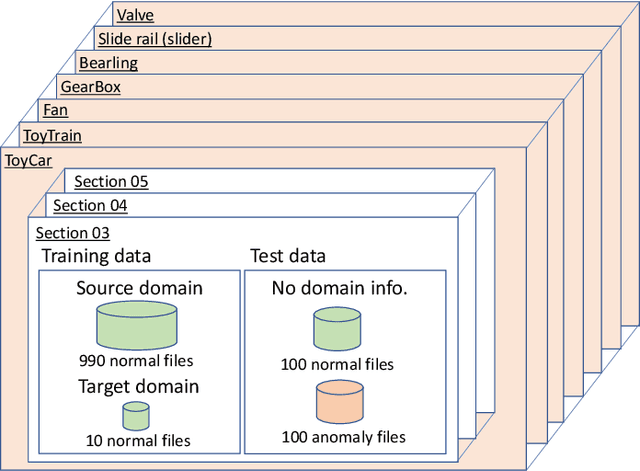
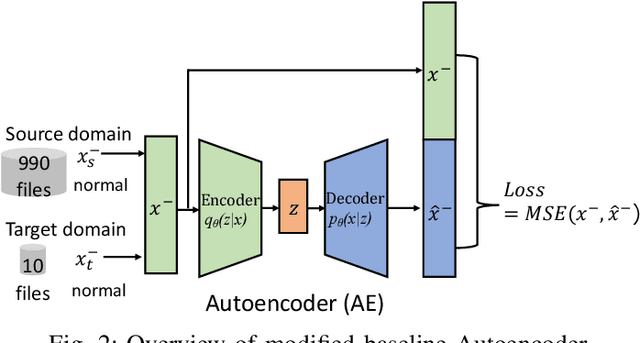
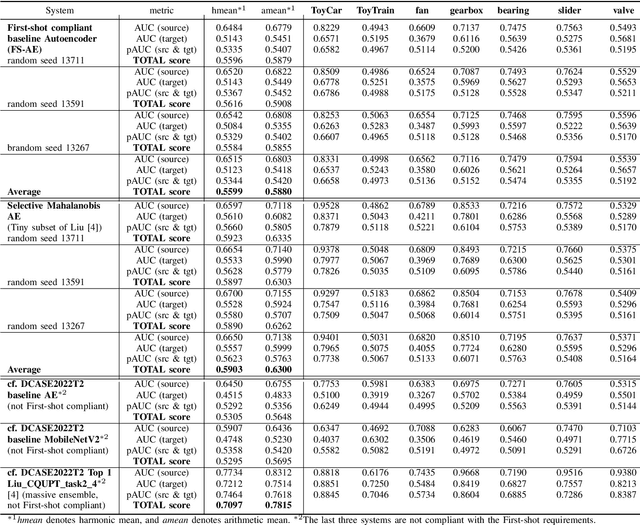
Abstract:This paper provides a baseline system for First-shot-compliant unsupervised anomaly detection (ASD) for machine condition monitoring. First-shot ASD does not allow systems to do machine-type dependent hyperparameter tuning or tool ensembling based on the performance metric calculated with the grand truth. To show benchmark performance for First-shot ASD, this paper proposes an anomaly sound detection system that works on the domain generalization task in the Detection and Classification of Acoustic Scenes and Events (DCASE) 2022 Challenge Task 2: "Unsupervised Anomalous Sound Detection for Machine Condition Monitoring Applying Domain Generalization Technique" while complying with the First-shot requirements introduced in the DCASE 2023 Challenge Task 2 (DCASE2023T2). A simple autoencoder based implementation combined with selective Mahalanobis metric is implemented as a baseline system. The performance evaluation is conducted to set the target benchmark for the forthcoming DCASE2023T2. Source code of the baseline system will be available on GitHub: https://github.com/nttcslab/dcase2023_task2_baseline_ae .
Multi-view and Multi-modal Event Detection Utilizing Transformer-based Multi-sensor fusion
Feb 18, 2022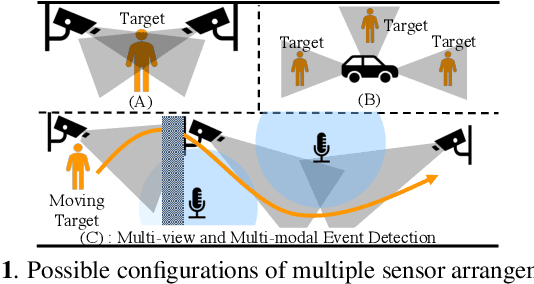
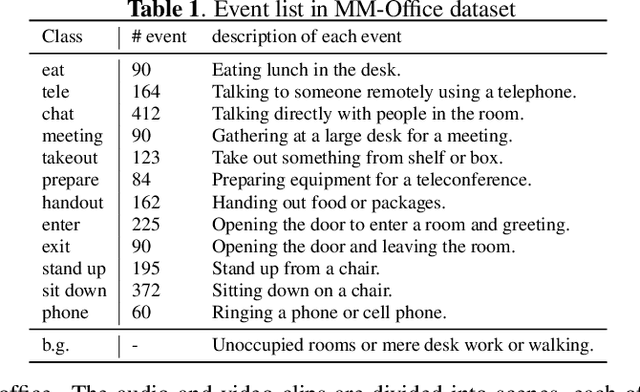

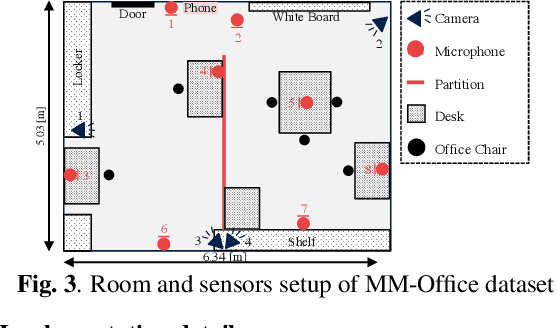
Abstract:We tackle a challenging task: multi-view and multi-modal event detection that detects events in a wide-range real environment by utilizing data from distributed cameras and microphones and their weak labels. In this task, distributed sensors are utilized complementarily to capture events that are difficult to capture with a single sensor, such as a series of actions of people moving in an intricate room, or communication between people located far apart in a room. For sensors to cooperate effectively in such a situation, the system should be able to exchange information among sensors and combines information that is useful for identifying events in a complementary manner. For such a mechanism, we propose a Transformer-based multi-sensor fusion (MultiTrans) which combines multi-sensor data on the basis of the relationships between features of different viewpoints and modalities. In the experiments using a dataset newly collected for this task, our proposed method using MultiTrans improved the event detection performance and outperformed comparatives.
 Add to Chrome
Add to Chrome Add to Firefox
Add to Firefox Add to Edge
Add to Edge